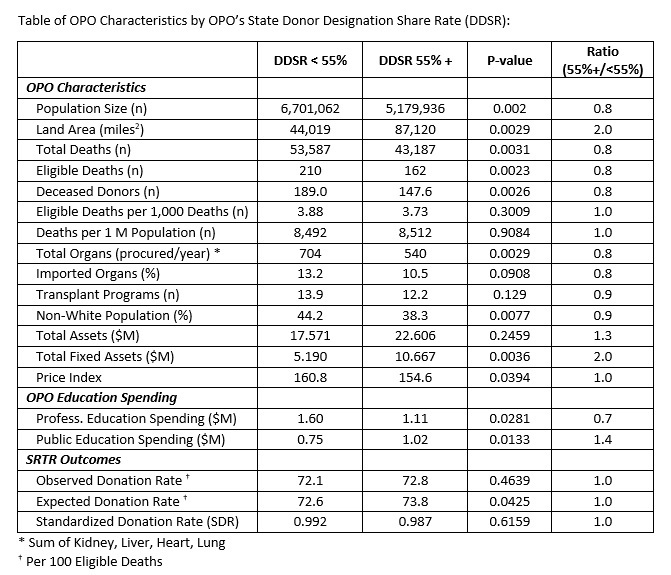Associations between State-Level Donor Designation Rate and Organ Procurement Organization Characteristics and Outcomes
1Kidney Epidemiology and Cost Center, Univ of Michigan, Ann Arbor, MI, 2Stanford University, Stanford, CA, 3University of California San Francisco, San Francisco, CA
Meeting: 2019 American Transplant Congress
Abstract number: D404
Keywords: Procurement, Public policy
Session Information
Session Name: Poster Session D: Late Breaking
Session Type: Poster Session
Date: Tuesday, June 4, 2019
Session Time: 6:00pm-7:00pm
 Presentation Time: 6:00pm-7:00pm
Presentation Time: 6:00pm-7:00pm
Location: Hall C & D
*Purpose: The impact of “Donor Designation (DDSR)”, a pledge to donate with state drivers licensing authority, has not been explored. This work focusses on estimating the associations between state-level DDSR and Organ Procurement Organization (OPO) characteristics and outcomes.
*Methods: Data sources: the OPO Cost Reports (CMS 216-94 Form), OPO Specific Reports (SRTR), Donate Life America Reports (DLA), and the US Census. Data were aggregated across 5-years (2013 to 2017). We report on a total of 237 OPO-years with complete data from 51 independent OPOs. Donor designation share rates (DDSR: the ratio of the number of individuals in the donor registry of a state by the adult population) were abstracted from the published DLA Reports. T-tests were performed comparing OPO characteristics, educational spending, and SRTR outcomes by high DDSR OPO-years (55%+) vs. low DDSR OPO-years (<55%). Linear mixed models were employed to examine the relationship between these two measures, accounting for other OPO characteristics and repeated OPOs.
*Results: Both donor designation rates and public education spending have been increasing over the past 5 years (DDSR: from 51.5% to 59.3% when examining all states and public education spending: $0.9 M to $ 1M/year). OPO characteristics differed markedly between the two DDSR groups. OPOs in states with high DDSR were less populated, had greater land area, fewer total and eligible deaths, fewer donors and organs, had fewer non-White residents, and more fixed assets. Educational spending also differed between groups, with OPOs in states with high DDSR spending less on professional education, but more on public educational. Observed donation rates and SDR did not differ between the groups. After accounting for OPO characteristics that showed significant differences, the positive association between public education spending and DDSR remained, suggesting for each million dollars spent per year (the IRQ range) there was a 3.4 percentage point higher DDSR (p=0.003).
*Conclusions: Statistically significant differences in OPO characteristics were seen when comparing OPOs in states with high compared to low DDSR. After accounting for the other characteristics, we found OPO’s that spent more on public education had higher DDSR. No differences were seen in terms of some OPO performance measures (e.g. Standardized Donor Rate). Further research is needed in this area as OPO resource allocation to education is an important policy issue.
To cite this abstract in AMA style:
Bragg-Gresham J, Held P, Roberts JP. Associations between State-Level Donor Designation Rate and Organ Procurement Organization Characteristics and Outcomes [abstract]. Am J Transplant. 2019; 19 (suppl 3). https://atcmeetingabstracts.com/abstract/associations-between-state-level-donor-designation-rate-and-organ-procurement-organization-characteristics-and-outcomes/. Accessed December 13, 2025.« Back to 2019 American Transplant Congress

